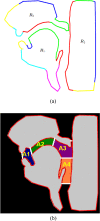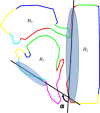An investigation of articulatory setting using real-time magnetic resonance imaging
- PMID: 23862826
- PMCID: PMC3724797
- DOI: 10.1121/1.4807639
An investigation of articulatory setting using real-time magnetic resonance imaging
Abstract
This paper presents an automatic procedure to analyze articulatory setting in speech production using real-time magnetic resonance imaging of the moving human vocal tract. The procedure extracts frames corresponding to inter-speech pauses, speech-ready intervals and absolute rest intervals from magnetic resonance imaging sequences of read and spontaneous speech elicited from five healthy speakers of American English and uses automatically extracted image features to quantify vocal tract posture during these intervals. Statistical analyses show significant differences between vocal tract postures adopted during inter-speech pauses and those at absolute rest before speech; the latter also exhibits a greater variability in the adopted postures. In addition, the articulatory settings adopted during inter-speech pauses in read and spontaneous speech are distinct. The results suggest that adopted vocal tract postures differ on average during rest positions, ready positions and inter-speech pauses, and might, in that order, involve an increasing degree of active control by the cognitive speech planning mechanism.
Figures



References
-
- Bockman, S. (1989). “ Generalizing the formula for areas of polygons to moments,” Am. Math. Monthly 96, 131–132.10.2307/2323197 - DOI
-
- Byrd, D., and Saltzman, E. (2003). “ The elastic phrase: modeling the dynamics of boundary-adjacent lengthening,” J. Phonetics 31, 149–180.10.1016/S0095-4470(02)00085-2 - DOI
-
- Esling, J., and Wong, R. (1983). “ Voice quality settings and the teaching of pronunciation,” TESOL Q. 17, 89–95.10.2307/3586426 - DOI
Publication types
MeSH terms
Grants and funding
LinkOut - more resources
Full Text Sources
Other Literature Sources
Medical

